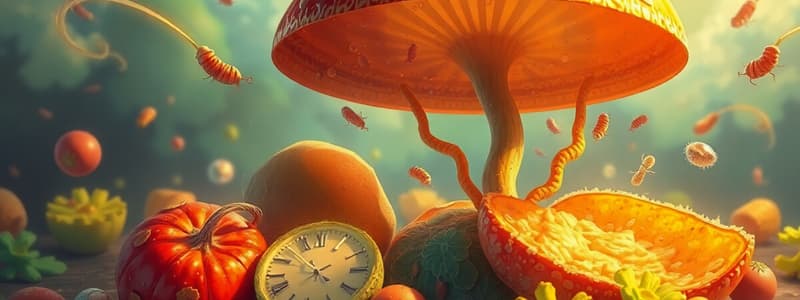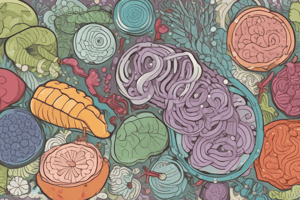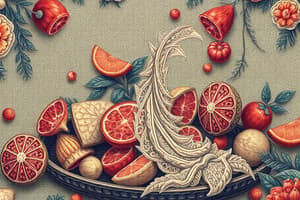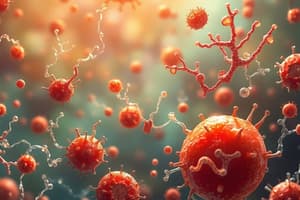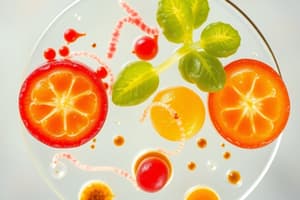Podcast
Questions and Answers
What is a major consequence of food spoilage?
What is a major consequence of food spoilage?
- Improved food safety
- Increased nutrient content
- Major cause of food waste (correct)
- Reduced food waste
Spoilage of food is defined as an improvement in the organoleptic properties of a food.
Spoilage of food is defined as an improvement in the organoleptic properties of a food.
False (B)
Which of the following is NOT a substance produced by microbes growing on food?
Which of the following is NOT a substance produced by microbes growing on food?
- Vitamins (correct)
- Esters
- Carbonyls
- Organic acids
Food pathogens are a subset of food spoilage organisms.
Food pathogens are a subset of food spoilage organisms.
Which illness results from Salmonella spp?
Which illness results from Salmonella spp?
Listeria monocytogenes, if it spreads beyond the gut, causes a stiff ______.
Listeria monocytogenes, if it spreads beyond the gut, causes a stiff ______.
Which of the following is commonly associated with Cyclospora?
Which of the following is commonly associated with Cyclospora?
Campylobacter is commonly found in properly pasteurized milk.
Campylobacter is commonly found in properly pasteurized milk.
What illness is associated with E. coli?
What illness is associated with E. coli?
C. botulinum can result in muscle weakness and blurred ______.
C. botulinum can result in muscle weakness and blurred ______.
Which of the following is an example of a food that utilizes the growth of microorganisms for its preservation?
Which of the following is an example of a food that utilizes the growth of microorganisms for its preservation?
Beer depends on the growth of microorganisms for its preservation.
Beer depends on the growth of microorganisms for its preservation.
Which of the following contains Acetic acid bacteria?
Which of the following contains Acetic acid bacteria?
Beer is brewed from grains and ______.
Beer is brewed from grains and ______.
Which of these has more fiber?
Which of these has more fiber?
Wine typically has a lower alcohol content than beer.
Wine typically has a lower alcohol content than beer.
What ingredient primarily causes tanginess in Sauerkraut?
What ingredient primarily causes tanginess in Sauerkraut?
Red wine is known for its ______, which are believed to contribute to heart health.
Red wine is known for its ______, which are believed to contribute to heart health.
Which of the following starter cultures are used to make yogurt?
Which of the following starter cultures are used to make yogurt?
Match the food with its consistency:
Match the food with its consistency:
Between Sauerkraut and Kimchi, which typically Shredded?
Between Sauerkraut and Kimchi, which typically Shredded?
Kimchi contains primarily cabbage, salt, and caraway seeds.
Kimchi contains primarily cabbage, salt, and caraway seeds.
What culture is used to ferment kefir?
What culture is used to ferment kefir?
Kimchi can be served in larger ______.
Kimchi can be served in larger ______.
What does food spoilage primarily affect?
What does food spoilage primarily affect?
Microbes are NOT a cause of food spoilage.
Microbes are NOT a cause of food spoilage.
An explosion of glass containers can be caused by what?
An explosion of glass containers can be caused by what?
Which of the following organisms is associated with unpasteurized milk?
Which of the following organisms is associated with unpasteurized milk?
E. coli is linked to vegetables.
E. coli is linked to vegetables.
Which of the following useful the growth of microorganisms for their preservation?
Which of the following useful the growth of microorganisms for their preservation?
Match the food with the acid it contains:
Match the food with the acid it contains:
Which of the following drinks are lower in alcohol content?
Which of the following drinks are lower in alcohol content?
Red wine is thought to contribute to heart health.
Red wine is thought to contribute to heart health.
Which of the following ingredients is typically found in sauerkraut?
Which of the following ingredients is typically found in sauerkraut?
Kimchi is spicy, salty, and ______.
Kimchi is spicy, salty, and ______.
Which of the following ingredients is in Kimchi, but NOT Sauerkraut?
Which of the following ingredients is in Kimchi, but NOT Sauerkraut?
Kimchi typically ferments for a longer period than sauerkraut.
Kimchi typically ferments for a longer period than sauerkraut.
Which of the following contains a symbiotic culture of bacteria and yeast?
Which of the following contains a symbiotic culture of bacteria and yeast?
Which of the following bacteria is present in Yogurt?
Which of the following bacteria is present in Yogurt?
Flashcards
Food Spoilage
Food Spoilage
Food spoilage causes food waste.
Spoilage Definition
Spoilage Definition
Change in food's organoleptic properties.
Spoilage Products
Spoilage Products
Microbes growing on food produce these.
Food Pathogens
Food Pathogens
Signup and view all the flashcards
Salmonella sptomps
Salmonella sptomps
Signup and view all the flashcards
Listeria Source
Listeria Source
Signup and view all the flashcards
Cyclospora Source
Cyclospora Source
Signup and view all the flashcards
Campylobacter Source
Campylobacter Source
Signup and view all the flashcards
E. coli source
E. coli source
Signup and view all the flashcards
C. botulinum Source
C. botulinum Source
Signup and view all the flashcards
Fermented Foods
Fermented Foods
Signup and view all the flashcards
Beer
Beer
Signup and view all the flashcards
Wine
Wine
Signup and view all the flashcards
Yogurt Cultures
Yogurt Cultures
Signup and view all the flashcards
Kefir
Kefir
Signup and view all the flashcards
Main sauerkraut ingredients
Main sauerkraut ingredients
Signup and view all the flashcards
What does kimchi use?
What does kimchi use?
Signup and view all the flashcards
Study Notes
- Undesirable microorganisms cause food spoilage, while desirable ones are useful in food production.
The Bad Guys: Food Spoilage
- Food spoilage contributes significantly to food waste.
- Spoilage is characterized by changes in a food's organoleptic properties.
- Microbes are the primary cause of food spoilage.
Microbial Products in Food
- Organic acids
- Esters
- Carbonyls
- Diamines
- Sulfur compounds
- Hydrocarbons
- Pigments
- Appearance of colonies
- Change in texture
The Bad Guys: Food Pathogens
- Food pathogens are a subgroup of food spoilage organisms that can cause illness in humans.
Specific Food Pathogens
- Salmonella spp: Found in vegetables, eggs, chicken, and pork, it causes diarrhea, fever, stomach cramps, and vomiting.
- Listeria monocytogenes: Present in unpasteurized milk and dairy products as well as ready-to-eat deli meats, raw fruits, and vegetables; it can cause stiff neck, confusion, fever, and muscle aches, and may lead to stillbirths in pregnant women.
- Cyclospora: Linked to raspberries, basil, cilantro, snow peas, and mesclun lettuce (including Arugula, Spinach, Swiss Chard, Endive, Kale, Mustards, and Lettuces), it causes diarrhea, loss of appetite and weight, stomach cramps/pain, bloating, increased gas, nausea, and fatigue, with symptoms appearing about one week after infection.
- Campylobacter: Found in unpasteurized milk, chicken, shellfish, turkey, and water; its symptoms include diarrhea, cramps, fever, and vomiting.
- E. coli: Associated with contaminated food (undercooked beef, milk, raw fruits, and vegetables) and causes severe diarrhea and stomach pain.
- C. botulinum: Results from improperly canned foods and honey in infants, leading to muscle weakness, blurred vision, and potentially death.
The Good Guys: Useful Microorganisms in Food
- The growth of useful microorganisms is crucial for the preservation of certain fermented foods.
- Examples of foods made with useful microorganisms include:
Examples of microorganisms in food
- Beer
- Wine
- Yogurt
- Kefir
- Vinegar (Acetic acid bacteria; Acetobacter)
- Sauerkraut
- Kimchi
Beer
- Produced from grains (such as barley) and hops; beer provides a range of flavors from light and crisp to dark and malty.
- Brewing is similar to cooking which allows for the addition of various ingredients and spices.
- It can contain protein, fiber, B vitamins, folate, and niacin.
- It typically has a lower alcohol content than wine, with a standard serving containing about the same amount of alcohol as a standard glass of wine.
- It is is generally more affordable than wine, especially when comparing higher-quality wines.
Wine
- Wines are made from fermented grapes.
- Wines typically have a more acidic and fruity taste profile.
- Flavor varies based on the grape variety, aging, and winemaking techniques used.
- Because of its antioxidants, particularly flavonoids and tannins, red wine is believed to contribute to heart health.
- Alcohol content is typically higher than that of beer and a pint of beer has 50% more energy.
Yogurt
- Primarily contains Lactobacillus bulgaricus and Streptococcus thermophilus.
- Result of fermentation of yogurt starter cultures which are bacteria.
- Yogurt has Milder and sweeter taste characteristics.
- A thicker, spoonable consistency is typical.
Kefir
- Contains a wider variety of bacteria and yeasts, including Lactobacillus kefiri, Saccharomyces cerevisiae, and Saccharomyces unisporus.
- Result of fermentation of keffir grains which are a symbiotic culture of bacteria and yeast.
- Tangier and slightly sourer taste.
- Thinner, more drinkable consistency.
Sauerkraut
- Primarily uses cabbage, salt, and sometimes caraway seeds.
- Has a more tangy and sour taste.
- Typically ferments for longer than kimchi.
- It is typically shredded.
Kimchi
- Uses a wide variety of vegetables (like napa cabbage, radishes, cucumbers, etc.) and spices (like gochugaru chili powder, garlic, ginger, etc.).
- Can be spicy, salty, and tangy depending on the ingredients and fermentation time.
- It can be served in larger chunks.
Studying That Suits You
Use AI to generate personalized quizzes and flashcards to suit your learning preferences.
